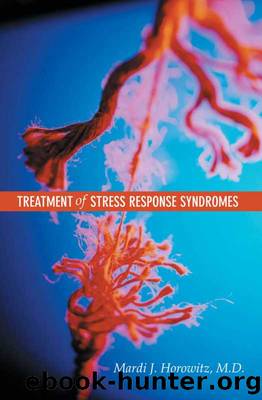Treatment of Stress Response Syndromes by Mardi J. Horowitz

Author:Mardi J. Horowitz
Language: eng
Format: epub, mobi
tity experiences may result. The more the person has coherent linkages of multiple self-schemas into supraordinate schemas, the more continuous will be that person’s sense of identity over time. The less the integration before the trauma, the greater the possibility for chaotic identity experiences in the posttraumatic period.
Role Relationship Models
Identity experiences are associatively primed and supported by current relationship experiences. Associations of self with other can be captured as a role relationship model. Such a model forms a cognitive map of the attributes, characteristics, and scripts of potential transactions of self and other. Scripts include future plans of self-intentions to move toward desired possible future identities and away from dreaded ones.
In associative processing, the possible meanings of a trauma are compared with each organized schematization of self in a relationship. Some people fear that usually latent schemas of personal vulnerability may be activated because of associative linkages of the actual vulnerability of self with the stressor events. If these dreaded schemas have not been previously attenuated by supraordinate schemas that can contain and diminish them, a regressive decompensation may occur. For example, an adult who has recently endured a traumatic experience may become especially distressed if the roles of a similar childhood trauma have never been mastered. Conversely, if those roles were mastered, the adult may adapt resiliently.
Role relationship models can be formulated for each salient state of mind (desired, dreaded, problematic, and protective). Doing so is valuable because the models are predictive of possible transference reactions that may complicate the therapeutic alliance. Such reactions are based on both positive and negative expectations. An illustration of an expanded configuration related to the states already discussed is shown in Figure 4-3.
As shown in Figure 4-3, the most dreaded state is one of intrusive horror. In terms of a negative transference expectation, the patient sees him-or herself as a helpless victim and the therapist as a powerful aggressor who mercilessly requires the patient to recount the story of the traumatic event, repeatedly subjecting the patient to an unwanted reliving of memory. The expectation is that the patient will express all of his or her vulnerabilities experienced during the trauma, will then be attacked by the therapist for not expressing his or her memories better or fully enough, and will experience terror at having to endlessly repeat a story that is so disturbing. Although this is not a rational expectation of a therapy situation, the traumatic repetition can be an unconscious expectation. For example, a victim of a rape assault may unconsciously expect that the therapy, in and of itself, will somehow represent a repetition of the rape—in effect, penetrating the patient’s mind by forcing him or her to talk about some of the physical acts.
A less intense negative transference expectation can occur in the problematic compromise state, one of anxious hypervigilance. In this state, the patient may self-identify as a needy victim who is making demands for help but expects that the therapist will be an inexpert or inconstant helper who will fail to meet his or her needs.
Download
Treatment of Stress Response Syndromes by Mardi J. Horowitz.mobi
This site does not store any files on its server. We only index and link to content provided by other sites. Please contact the content providers to delete copyright contents if any and email us, we'll remove relevant links or contents immediately.
Should I Stay or Should I Go? by Ramani Durvasula(6784)
Why We Sleep: Unlocking the Power of Sleep and Dreams by Matthew Walker(5641)
Fear by Osho(4085)
Flow by Mihaly Csikszentmihalyi(4052)
Rising Strong by Brene Brown(3780)
Why We Sleep by Matthew Walker(3771)
Too Much and Not the Mood by Durga Chew-Bose(3693)
How to Change Your Mind by Michael Pollan(3676)
The Hacking of the American Mind by Robert H. Lustig(3580)
Lost Connections by Johann Hari(3455)
He's Just Not That Into You by Greg Behrendt & Liz Tuccillo(3300)
Evolve Your Brain by Joe Dispenza(3050)
What If This Were Enough? by Heather Havrilesky(2945)
Resisting Happiness by Matthew Kelly(2887)
Crazy Is My Superpower by A.J. Mendez Brooks(2860)
The Courage to Be Disliked by Ichiro Kishimi & Fumitake Koga(2796)
The Book of Human Emotions by Tiffany Watt Smith(2770)
Descartes' Error by Antonio Damasio(2731)
In Cold Blood by Truman Capote(2684)
